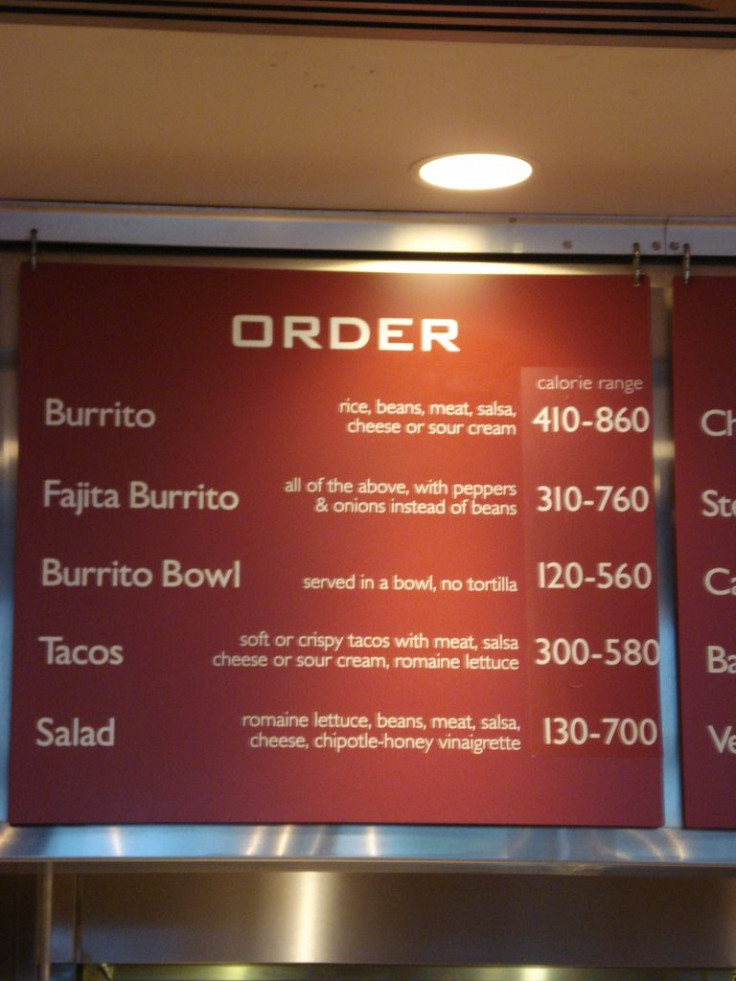Calorie Counts On Fast Food Menus Don't Work: One-Third Of Consumers Eat 57% More Calories Than They Should

In a world where calorie counts often come before prices on menus, one has to wonder if having health information changes anything for those choosing to eat at fast food restaurants.
In a new study, 1,121 adult lunchtime diners at two McDonald's restaurants in New York City were surveyed for changes to their calorie intake based on caloric information given. The surveys were performed two months before and after New York City mandated that all restaurants include calorie counts in their menus in 2008.
To explore the potential interaction between menu labeling and the addition of recommended calorie intake information, three groups of diners received different information: recommended daily calorie intake, recommended calorie intake per meal, and no additional information. Survey data was also gathered to capture the diners' understanding of calorie consumption.
One group of study participants was given a piece of paper before entering the restaurant that said doctors or nutritionists recommend the intake of 2,000 calories daily, while another group was given a similar piece of paper, phrased in a similar way but geared toward calories per meal (650 to 800). Each slip of paper also gave the added direction that it needed to be returned to whoever gave it to them. About two-thirds of those slips were returned, indicating that people had read the slips and their decisions about food were either affected or unaffected by the information given to them.
Researchers found that in spite of the information given, more than half of the participants still ordered beyond suggested caloric intake. Men ordered an average of 890 calories and women ordered an average of 824 calories, while one-third of the 1,121 participants ordered more than 1,000 calories worth of food at the restaurant — this is about 57 percent more than anyone should consume in one meal. The researchers did, however, find some reduction in calories purchased after caloric information was posted on menus, and after per-meal caloric recommendations were given. But, it was only a difference of about 50 calories, which, at fast food restaurants, does not signify much change. Researchers even found that those given a daily caloric intake recommendation after the calories were posted on menus ordered about 50 calories more than they did before the caloric information was posted.
"There have been high hopes that menu labeling could be a key tool to help combat high obesity levels in this country, and many people do appreciate having that information available. Unfortunately, this approach doesn't appear to be helping to reduce consumption very much, even when we give consumers what policymakers thought might help: some guidance for how many calories they should be eating," said the study's lead author Julie Downs, Ph.D.
Downs suggests that the calorie counts do nothing at all for consumer habits. But consumers are not to blame, as not all of them have the desire to stringently count their calories, she says.
"People who count calories know that this is a pretty labor-intensive exercise," Downs said. "Making the information available on menus may have other beneficial effects, such as motivating restaurants to change their formulations. But it may be unrealistic to expect many consumers to keep such close, numeric track of their food intake by using the labels directly."
Source: Downs JS, Wisdom J, Wansink B, Loewenstein G. Supplementing Menu Labeling With Calorie Recommendations to Test for Facilitation Effects. American Journal of Public Health. 2013.



























